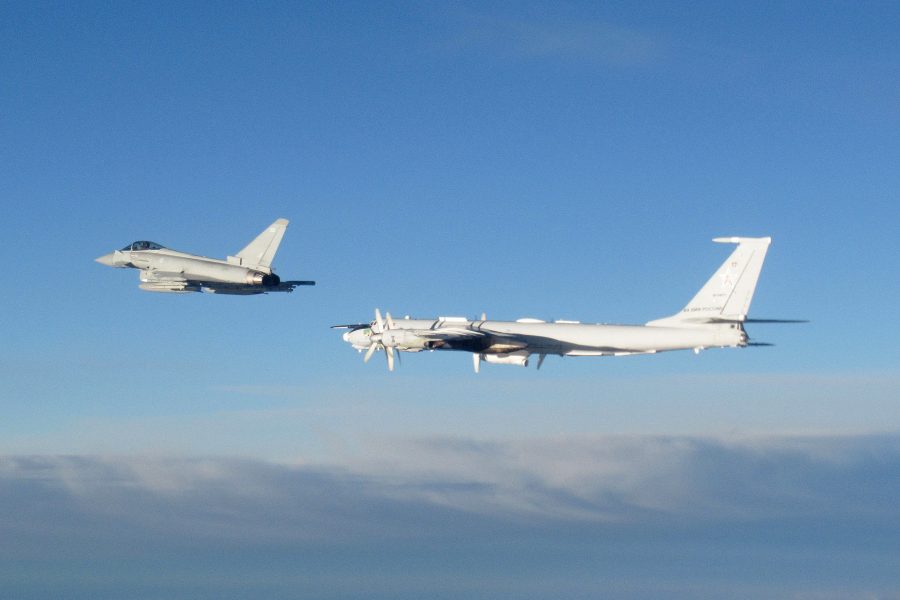Four Russian military aircraft operated near Alaska, according to North American Aerospace Defense Command, roughly two weeks after a flotilla of Russian and Chinese warships conducting joint exercises near the Aleutian Islands were shadowed by the Navy.
On the same day, thousands of miles away, Russian bombers also got near NATO airspace in Europe, prompting multiple countries to respond.
The incident near Alaska occurred late Aug. 13 and into the early morning hours of Aug. 14, according to a release from NORAD.
The command said it “detected and tracked” the Russian aircraft, but did not say whether American or Canadian aircraft were scrambled in response, as they sometimes have in the past. NORAD also did not identify what type of Russian aircraft were operating. The command did not immediately respond to queries.
NORAD did clarify that the Russian aircraft operated in the Alaska Air Defense Identification Zone (ADIZ), which is international airspace that serves as a buffer for early-warning defense of North America. Russia regularly conducts flights in that area, with the last announced incident occurring July 3, also involving four Russian aircraft.
“These types of flights are not that uncommon,” Pentagon Press Secretary Air Force Brig. Gen. Patrick S. Ryder told reporters Aug. 14.
“The Russian aircraft remained in international airspace and did not enter American or Canadian sovereign airspace,” the NORAD release stated. “This Russian activity in the Alaska ADIZ occurs regularly and is not seen as a threat.”
Elsewhere on Aug. 14, multiple NATO countries scrambled fighters in response to Russian bomber flights near their countries.
Two Royal Air Force Typhoons on quick reaction alert from RAF Lossiemouth intercepted what it identified as Tu-142 Bear-F and Tu-142 Bear-J maritime patrol aircraft, which are used for “reconnaissance and anti-submarine warfare,” according to the RAF. The Russian bombers were flying north of the Shetland Islands, a Scottish archipelago that is the northern-most part of the U.K. The British also scrambled a Voyager refueling aircraft.
Like NORAD, the RAF also noted such incidents are not rare but said the Russian planes “can pose a hazard to other aircraft.”
“These Russian aircraft often do not talk to air traffic control or ‘squawk’, broadcasting a code ensuring they are visible to other air users and air traffic controllers on the ground,” an RAF release added.
The British pilots were “ready to counter any potential threat to U.K. territory” and “take action at a moment’s notice to keep our country safe,” U.K. Minister for the Armed Forces James Heappey said in a statement.
The incident was within NATO’s air policing zone, but in international airspace. The Danish Air Force aircraft also intercepted two Russian Bears in the morning of Aug. 14 in what appeared to involve the same Russian aircraft, according to the Netherlands. Two Dutch F-16s from Volkel Air Base were scrambled as the aircraft “flew towards Dutch airspace,” but the Russian aircraft changed course.
“This does not happen often, but today’s incident does demonstrate the importance of rapid employability,” the Dutch Ministry of Defense said in a statement.
The incidents come in the midst of Russia’s invasion of Ukraine and on the heels of 11 Russian and Chinese warships conducting drills near the Aleutian Islands, which were monitored four U.S. destroyers—the USS John S. McCain, the USS Benfold, the USS John Finn, and the USS Chung-Hoon— and P-8 Poseidon aircraft. However, Ryder said the latest Russian flights near Alaska did not appear to be linked to that incident.
“No indication that I’m aware of that’s it’s linked to any exercise activity,” Ryder said of the flights, but added the U.S. had a policy to “make people aware.”
